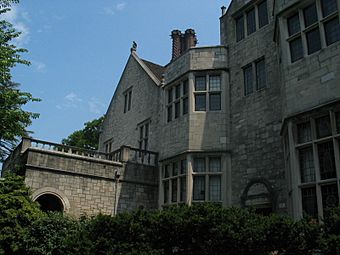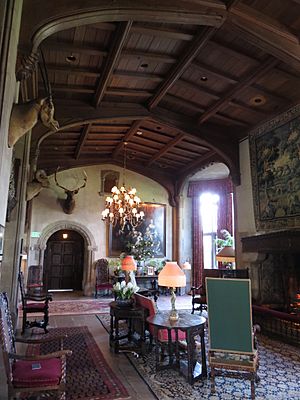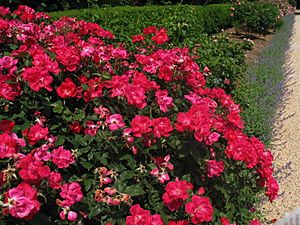Planting Fields Arboretum State Historic Park facts for kids
Quick facts for kids |
|
|
Planting Fields Arboretum
|
|

Coe Hall at Planting Fields Arboretum
|
|
| Lua error in Module:Location_map at line 420: attempt to index field 'wikibase' (a nil value). | |
| Nearest city | Oyster Bay, New York |
|---|---|
| Built | 1915 |
| Architect | Guy Lowell; Walker & Gillette |
| Architectural style | Tudor Revival |
| NRHP reference No. | 79001598 |
| Added to NRHP | January 25, 1979 |
Planting Fields Arboretum State Historic Park is a huge park and garden, called an arboretum, that covers over 400 acres in Oyster Bay, New York. Inside the park is the amazing Coe Hall Historic House Museum, a mansion with 67 rooms.
The estate, originally named Planting Fields, was the home of William Robertson Coe and his wife, Mary "Mai" Coe. Mr. Coe was a wealthy executive in the insurance and railroad industries. Mai's father was Henry H. Rogers, a famous industrialist who was a leader at the Standard Oil company. They built their home near the end of the Gilded Age, a time in American history when some families became incredibly rich.
The park includes the giant Coe Hall, greenhouses full of plants, beautiful gardens, and paths through the woods. The grounds were designed by famous landscape architects, including the Olmsted Brothers. Planting Fields also has an herbarium, which is like a library of over 10,000 pressed and preserved plant specimens for study.
The name "Planting Fields" comes from the Matinecock people, a Native American tribe that once grew crops on this fertile land.
Contents
The Story of Planting Fields
The land that is now Planting Fields is on Long Island's "Gold Coast," an area known for its grand estates. Between 1904 and 1912, a lawyer's wife named Helen MacGregor Byrne bought several farms and called them "Upper Planting Fields Farm." She hired a landscape architect to create gardens, but much of the land was still wild.
Building a Dream Estate
In 1913, William Robertson Coe bought the 353-acre property. He and his wife Mai wanted to turn it into a botanical wonderland. They hired top landscape designers to plan the gardens and bring in plants from all over the world.
One of their most amazing projects was moving two huge beech trees in 1915. The trees came from Mai's childhood home in Massachusetts. They were so big that their roots were wrapped in balls of dirt 30 feet wide! The trees were floated across the Long Island Sound on a ferry. Roads had to be widened just to let them pass. Sadly, only one of the giant trees survived the trip.
The Coes also bought thousands of rhododendrons from England and many other special trees, like Japanese crabapples and pines.
A New Mansion is Born
Tragedy struck on March 19, 1918, when the family's first mansion on the property burned down. They immediately began building a new one. The new house, the Coe Hall we see today, was built between 1918 and 1921.
It was designed in a style called Tudor Revival, which was inspired by old English country houses. The outside is covered in beautiful Indiana limestone.
Mai Coe was sick for many years and passed away in 1924. In 1949, Mr. Coe gave the entire estate to the state of New York so that it could become a public park for everyone to enjoy.
Exploring the Main Gardens
The gardens at Planting Fields are filled with incredible plant collections from around the world. Each garden has its own unique style and features.
Famous Garden Areas
- The Italian Blue Pool Garden: This garden was created between 1914 and 1918. It features a beautiful pool and a Tea House. It was originally planted with colorful flowers like delphiniums, irises, and peonies.
- The Green Garden: This peaceful garden has a circular pool at its center. Nearby are paths lined with hundreds of varieties of azaleas and rhododendrons.
- The Rose Garden: This area features over 680 different types of roses, including Tea roses and miniature roses.
- The Synoptic Garden: This is a living library of plants! It has over 500 types of trees and shrubs, all arranged in alphabetical order by their scientific name.
Special Plant Collections
- Camellia Greenhouse: This greenhouse was built in 1917 just to hold the Coes' amazing collection of camellia plants. Today, it has over 300 plants, some of which were the first of their kind in the United States.
- Main Greenhouse: This large greenhouse was built between 1914 and 1929. It is home to huge collections of orchids, cacti, tropical houseplants, and ferns. It also features seasonal flower shows.
- Holly and Conifer Collections: The park has over 100 different types of evergreen holly trees. There is also a garden of dwarf conifers (cone-bearing trees) and a trail with giant conifers that can grow over 60 feet tall.
Finally, there are over 200 acres of woodland with miles of walking trails, allowing visitors to see what the land was like long ago.
From College to Park
For a short time, from 1955 to 1964, the estate was used as a temporary college campus for the State University of New York (SUNY). The school, which later became Stony Brook University, used Coe Hall for its main building. Students even lived in the old stables! After the university moved to its permanent campus, the site officially became the park we know today.
Planting Fields Today
Today, Planting Fields is run by New York State and is a popular place for visitors. The beautiful wrought-iron gates at the entrance are famous themselves. They were made in England in 1712 and were brought to the estate by Mr. Coe in 1921. They have even appeared in movies!
In 1979, Planting Fields Arboretum was added to the National Register of Historic Places, recognizing it as one of America's important historical sites.
See also
Images for kids









